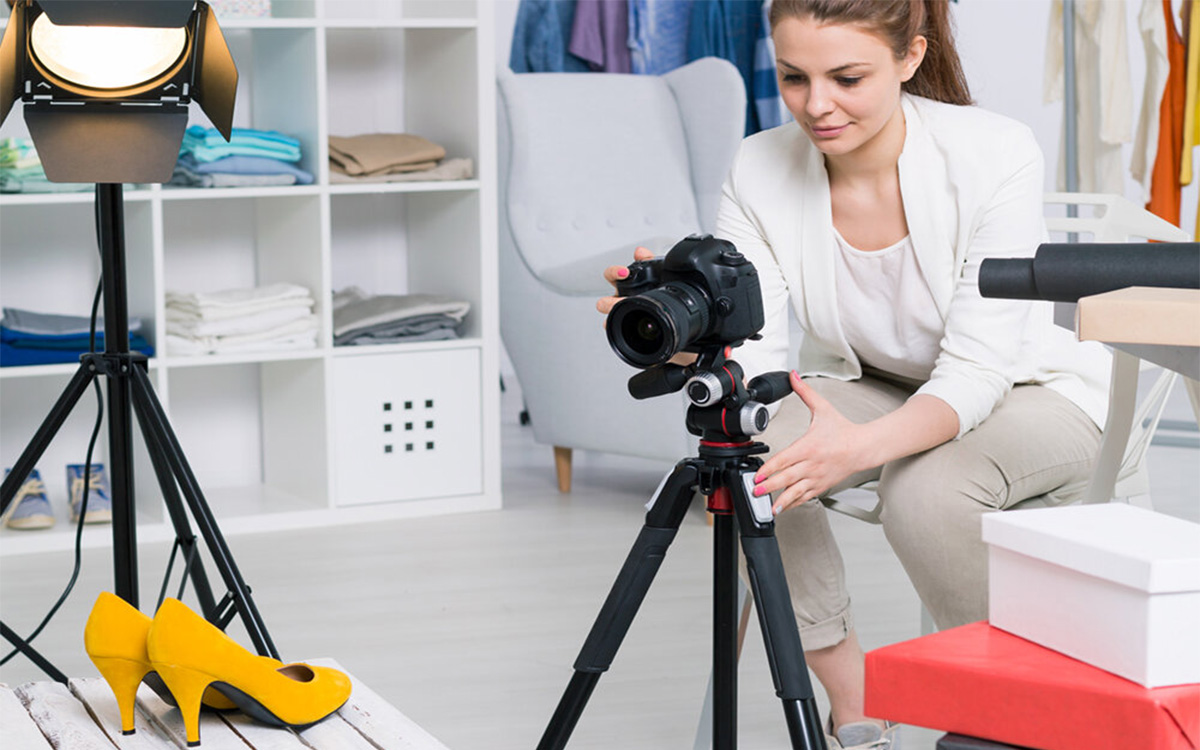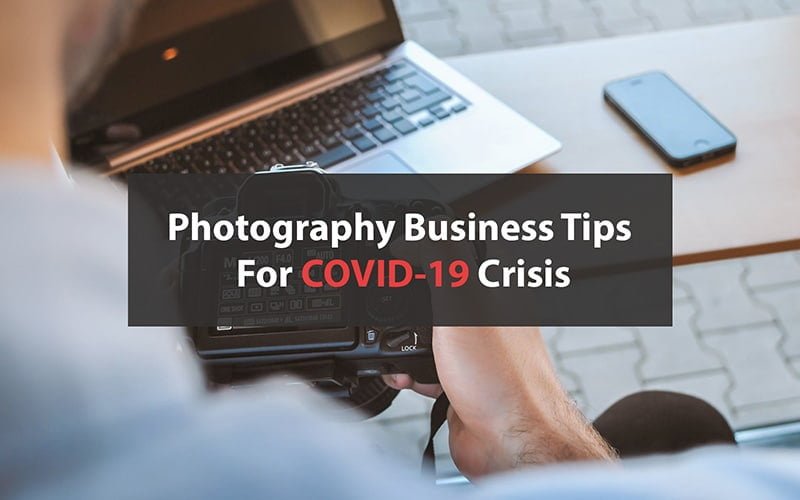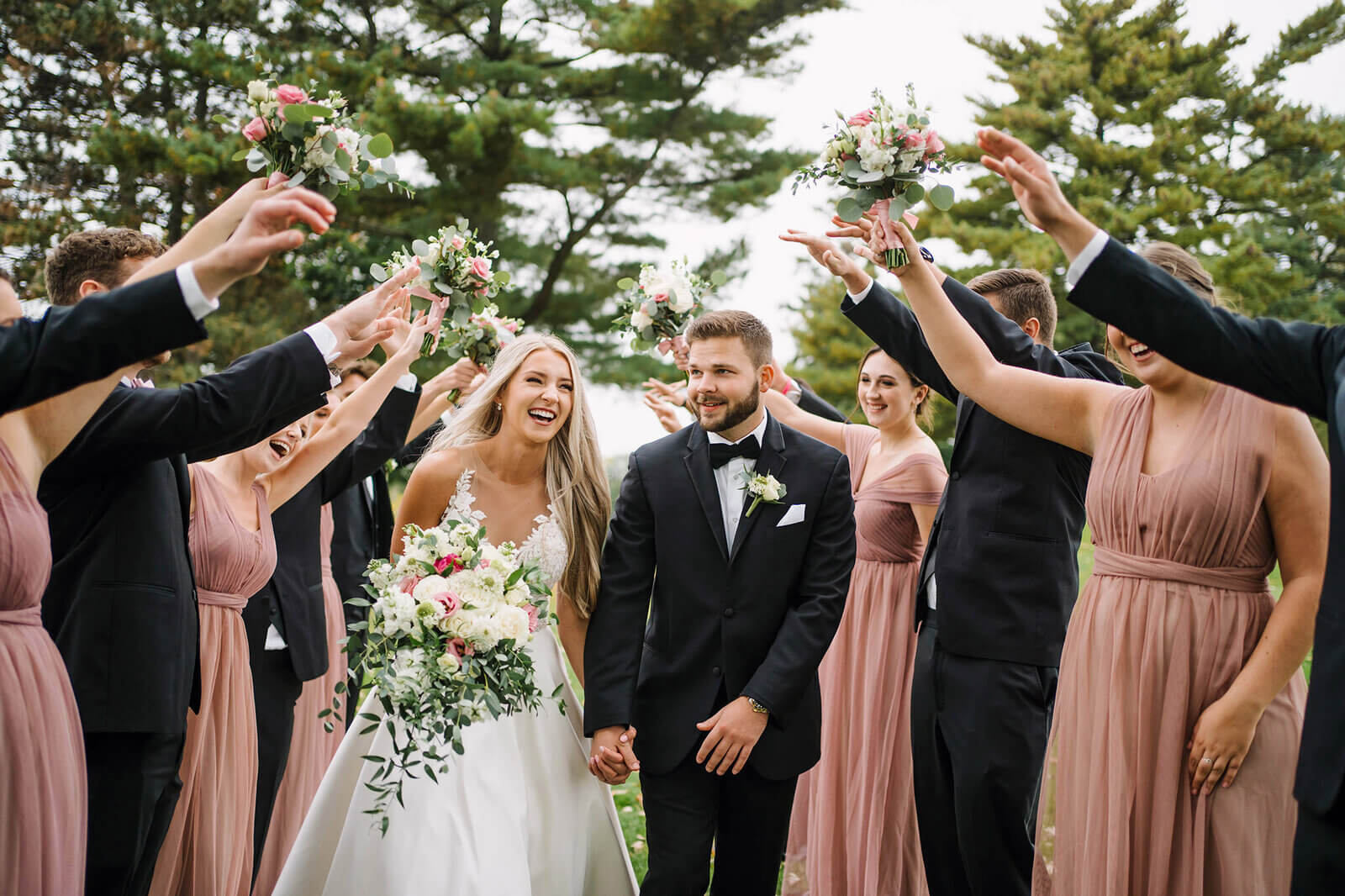As an online entrepreneur, it’s cool to know a few tricks about photography and take creative product photographs. It would help you reduce the cost of taking product pictures. And guess what? If you’re thinking of taking DIY pictures, there are entry-level cameras that any photography hobbyist with a great and keen eye for great pictures can use to get great DIY product pictures.
Aside from your creativity, you’ll still need to get great entry-level product photography, especially if you’re a beginner. Couple it with great lighting, and you might not need to hire a photographer in a while to get a great shot of your product for your e-commerce store. So, if you’re a beginner or you’re trying to invest in a great entry-level camera for your product photography, peep our list to grab the camera that’s best for you.
What you’ll learn in this article
- 1 Is It a Wise Decision to Buy an Entry-Level Camera?
- 2 Top 10 Best Entry-level Camera For Product Photography In 2024
- 2.1 1. Nikon D3200 DSLR Camera for Beginners
- 2.2 2. Canon EOS Rebel T7 DSLR Camera
- 2.3 3. Canon EOS 4000D DSLR Camera
- 2.4 4. Canon EOS REBEL T7 DSLR Camera
- 2.5 5. Panasonic LUMIX FZ80 Digital Camera
- 2.6 6. Nikon D5600 Digital SLR Camera
- 2.7 7. Canon EOS M50 Mirrorless Camera
- 2.8 8. Sony Alpha a6000 Mirrorless Digital Camera
- 2.9 9. Olympus OM-D E-M10 Mark IIIs Silver
- 2.10 10. Nikon D3500 Digital Camera
- 3 Mirrorless or DSLR – Which Camera Best for Product Photography
- 4 Things To Consider Before Buying A Good Entry-level Camera
- 5 FAQS about Best Entry-Level Cameras for Product Photography
- 6 Final Verdict
Is It a Wise Decision to Buy an Entry-Level Camera?

The answer to this question is quite ambiguous. That’s because it depends on the photographer and the nature of the project. For starters, if you’re a beginner in photography who’s trying to brush up on your photography skills and you urgently need pictures of your products, then it’s wise to buy an entry-level camera, and here’s why; you’re a beginner photographer.
The reason entry-level cameras can never appeal to professional photographers is that they a very basic and would hinder them from expressing their expertise in photography. They’ll need more of an advanced and sophisticated camera that’ll enable them fully play around with the pictures they take to get a great picture.
However, as a beginner photographer who’s still learning everything about photography and editing, you have no business buying a professional camera.
It doesn’t matter how long you’ve been learning photography. What matters is how skilled you’ve become from learning photography. Taking things step by step in photography would mature you faster.
So, unless you want to buy a camera for a professional photographer to use when taking your pictures of your products, stick to entry-level cameras; they are essential for your growth as a photographer or hobbyist photographer.
Top 10 Best Entry-level Camera For Product Photography In 2024
As a beginner photographer, you will be overwhelmed if you dive right into the market to purchase a camera. Before choosing to buy, check camera specifications.
Here is a list of the top 10 best entry-level cameras for product photography.
1. Nikon D3200 DSLR Camera for Beginners
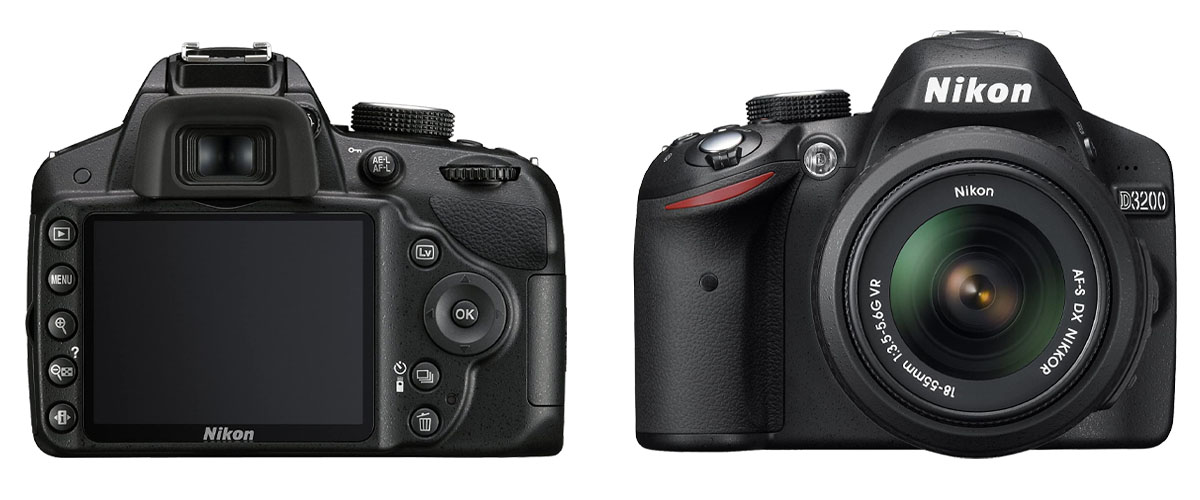
The first on our list is the Nikon D3200 DSLR camera. It’s a versatile camera with 24mp suitable for both entry-level photographers and professional photographers. Nikon made it easy for beginners to take great shots with this camera. They give photographers the luxury of shooting fantastic images using six scene settings, including the portrait and night portrait mode and close-up mode.
If you have a cool video idea to advertise your product, this Camera will come through for you with its cinematic HD 1080p video quality. The best part is, sending your pictures and videos to your smartphone or laptop is easy with the seamless wireless transfer.
| Pros | Cons |
| It is compact and lightweight. | Comes with a non-vibration resistance lens that makes it difficult to shoot pictures without a tripod and remote. |
| Deploys an 11-point autofocusing system that aids precise and fast shooting. | |
| Full HD 1080p video quality for cinematic video quality. | |
| Six settings for a great picture look and feel. | |
| Interchangeable lense for high-quality pictures. |
2. Canon EOS Rebel T7 DSLR Camera

With both manual and an automatic mode, you know you’ve found a camera companion in this Canon entry-level camera that wants you to grow into an expert in no time. For starters, the picture quality is incredible, thanks to the 24mp and the image stabilization feature.
This feature helps you take images and videos that are less blurry, making you a bit more confident in the possibility of becoming an expert photographer. A DSLR camera with a CMOS sensor drastically reduces noise in pictures and fast autofocus.
Although you’re a novice, you’ll feel less frustrated when shooting your products for your e-commerce store. The controls on this Camera aren’t a lot, so you won’t feel overwhelmed while trying to use it. Besides, it is easy to operate.
| Pros | Cons |
| CMOS sensor for reduced picture noise and high-quality images. | Doesn’t easily adjust to high contrast lighting. |
| Fast Autofocus | |
| Image stabilization makes it easy to get less blurry pictures. |
3. Canon EOS 4000D DSLR Camera
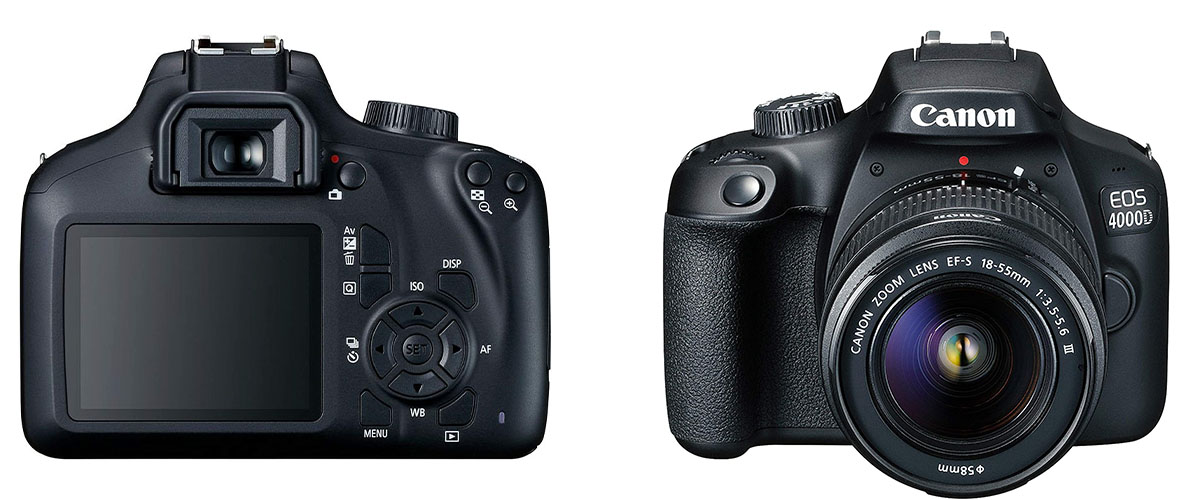
This Camera is another DSLR camera from Canon, and it is flexible. By flexible, it’s been constructed in a way that suits the needs of both beginner and professional photographers. Although it shoots at 18mp, the CMOS sensor contributes to nearly perfect image and video quality. It also takes videos in full HD 1080p and enables you to share them wirelessly to your devices for editing and other platforms.
Canon adds a beautiful surprise in this box for you: the wide-angle camera lens that helps you easily deploy the depth of field feature to give your picture a professional look. The best part is that you can easily mount this lens on the Camera with zero stress or complication.
| Pros | Cons |
| 9-point autofocus that contributes to fantastic pictures. | Doesn’t come with enough instruction. |
| Wide-angle lens to easily incorporate depth of field. | |
| Includes two long-lasting batteries. |
4. Canon EOS REBEL T7 DSLR Camera
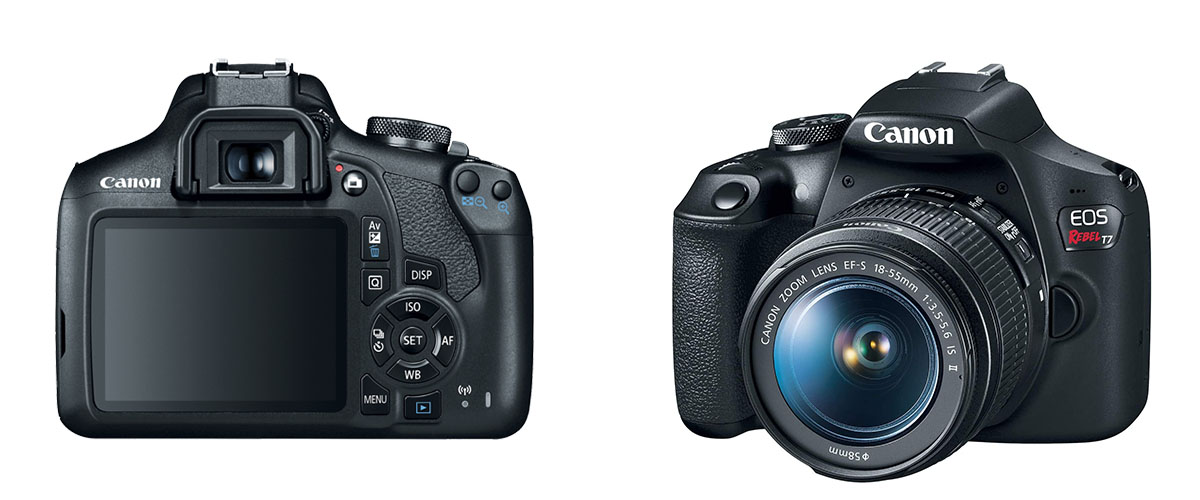
This Canon DSLR camera comes with 2 lens kits to optimize your photography skills. This Camera allows you to shoot in aperture priority mode. That means you can select your aperture manually while the camera adjusts the ISO and shutter speed to meet your desired aperture setting.
Of course, you’ll need a level of knowledge of how aperture works in terms of ISO and shutter speed to make this shooting mode work for you. Aside from the aperture mode, it has the image stabilization feature that makes your image clear to a reasonable extent. The lens also allows you to shoot your product with the depth of field feature that makes it stand out.
| Pros | Cons |
| Manual and Automatic mode to help beginners actively grow their skills | The battery might not be durable or long-lasting. |
| Wide-angle lens for depth of field | |
| Image stabilization for reduced blur. | |
| CMOS sensor and 24 mp capture all the color-clean images. | |
| Perfect for night/ low-light shots. |
5. Panasonic LUMIX FZ80 Digital Camera
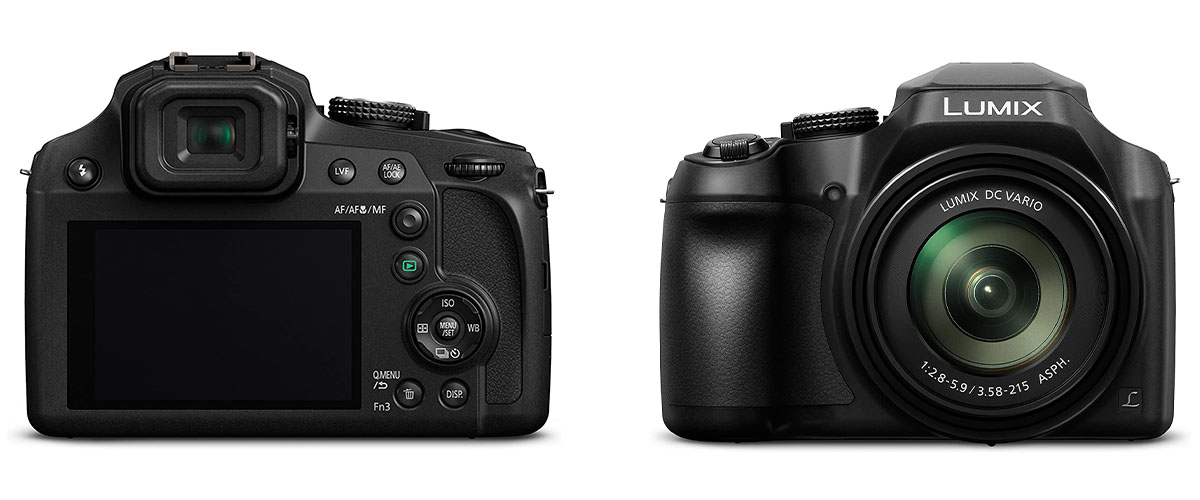
This compact, easy-to-operate Camera from Panasonic deploys the image stabilization feature to eliminate the blur in pictures. It’s the perfect camera for amateurs and newbies. The best part about this entry-level photography camera is that it gives you the luxury of shooting videos in 4K. with that in mind, you can freely execute every video concept you’ve had in mind regarding your product.
Panasonic adds the converter lens to this camera, so you’ll enjoy a wide range of focal lengths. In summary, the converter lens expands the capacity of your Camera. More so, you can also shoot at night without worrying about the outcome.
| Pros | Cons |
| Converter lens broadens the focal length range of your Camera. | It doesn’t have a focus ring. |
| Shoots videos in 4K. | |
| Only shoots in manual mode to encourage growth. | |
| Fast autofocus and zoom. |
6. Nikon D5600 Digital SLR Camera
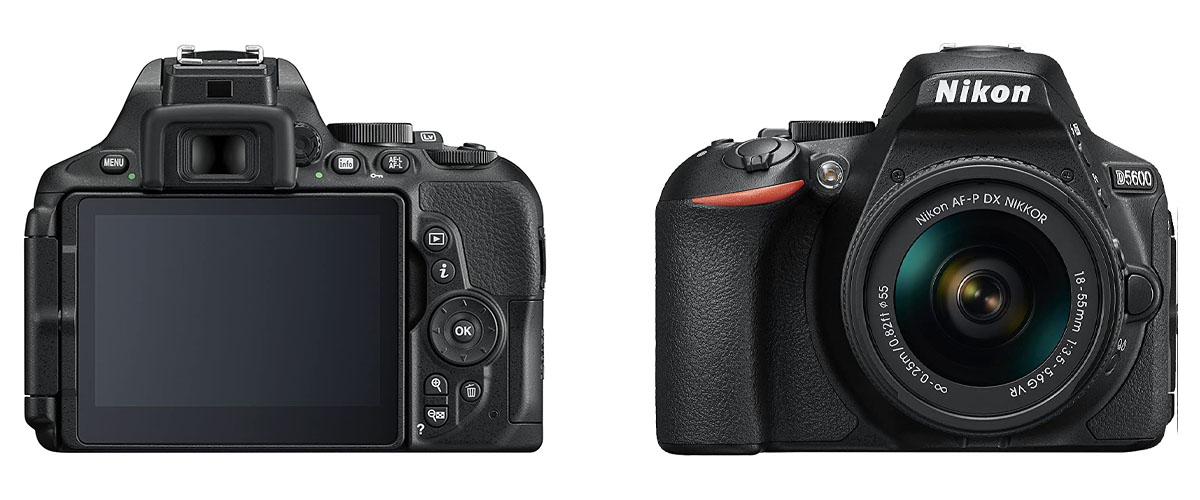
Nikon strikes again with this DSLR camera that’s specifically framed for beginners. This Camera allows its user to shoot in a wide variety of modes. Photographers can easily switch into any of these modes when they’re shooting specific themed subjects like food, selective color, during dusk or dawn, etc.
Feel free to play with these shooting mode options. It allows you to record videos in full HD 1080p mode. The result is a cinematic quality movie. Blend this cinematic quality video with fantastic sound quality, and you already have a great ad for your product.
Every shot taken with this Camera comes out clear, crisp, and deeply detailed. The noise also becomes almost non-existent in the picture. You can change the lens of this Camera for a better one from Nikon to capture better picture quality.
| Pros | Cons |
| Shoot your pictures with any compatible lens of your choice as it’s interchangeable. | Autofocus doesn’t work perfectly in video mode. |
| It allows you to shoot 5 frames per second. | |
| This camera pairs great sound quality with clear, sharp, and vibrant picture quality. |
7. Canon EOS M50 Mirrorless Camera

This Camera is a mirrorless camera from Canon that both entry-level photographers and professionals can use. It is compact but powerful in how it captures images in 4k mode. The impact is you’ll naturally get vibrant and colorful images with no detail missing.
It deploys a dual pixes CMOS which is the perfect option for mirrorless cameras as it helps the Camera focus faster on the subject to deliver clearer, crisper images. You’ll naturally have the luxury of focusing on a wide area of the image you seek to capture.
It operates perfectly with a 24.1 mp and DIGIC 8 image processor to enhance your CMOS while facilitating the built-in image stabilization that leads to clearer, crisper image quality. You can also shoot videos in 4K.
| Pros | Cons |
| It is compact and lightweight. | Might encounter issues with the battery not lasting long. |
| Deploys dual pixel CMOS for faster focus and clearer images | |
| Easy transfer of images and videos with wireless connectivity. | |
| Shoots images and videos in 4K. | |
| Interchangeable lenses allow you to maximize the potentials of this Camera. |
8. Sony Alpha a6000 Mirrorless Digital Camera

This Sony camera is both great for amateurs and professionals. Don’t worry; as an amateur, you won’t feel overwhelmed using this Camera as it deploys simple controls. This Camera deploys the fast hybrid AF feature for precision capturing and quick response when shooting fast-moving objects. This makes it ideal for your product photography.
So, if you’d like to naturally add a water splash effect to your product, this Camera would capture every detail along with your product, executing your concept easily.
Sony also deploys innovation at its best with this Camera through the 24MP APS-C sensor that skillfully balances the sensor dynamics and high resolution so that you’ll enjoy benefits like autofocus and subject tracking, especially when you’re shooting a video. The Camera is lightweight and compact.
| Pros | Cons |
| Deploys camera apps to maximize your creativity when shooting. | The audio quality is not perfect. |
| Uses an OLED viewfinder to aid precision shooting. | |
| The controls are simple and intuitive to control. |
9. Olympus OM-D E-M10 Mark IIIs Silver
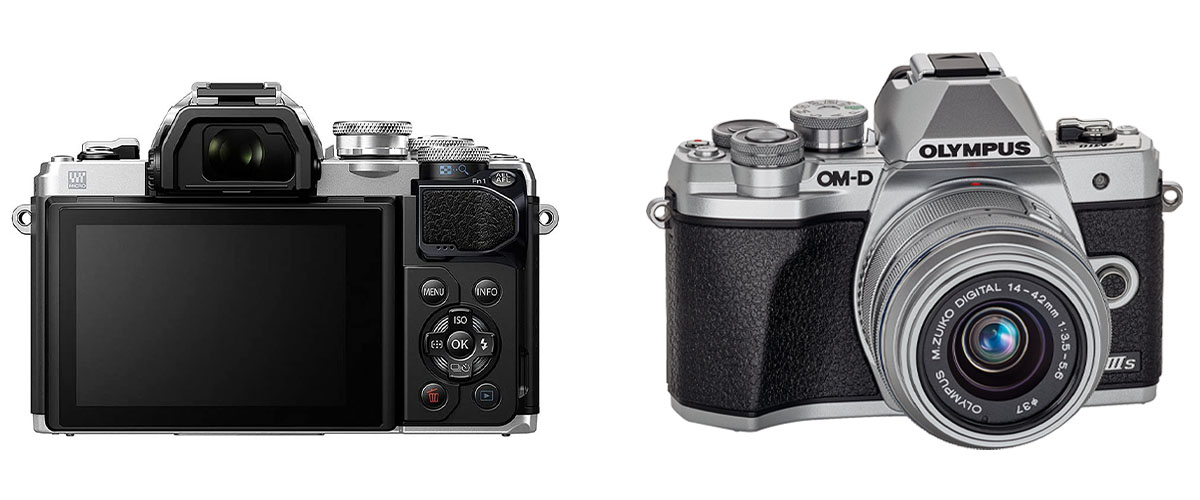
This mirrorless camera from Olympus was specifically designed for beginners. It’s great for video, and it’s thanks to the built-in image stabilization that still captures images without blur even when you’re moving the camera.
It deploys the touch AF feature that allows you to focus on your subject with a simple screen tap. Of course, you’ve got treats in the form of amazing filters. Preview what each filter would look like on the screen before you proceed to capture your image with the chosen filter of your choice.
| Pros | Cons |
| Settings are easy, so you don’t need to feel intimidated. | Shooting videos in 4k blocks out quite a few settings. |
| Shoot videos in beautiful 4K stunning resolution. | |
| Add amazing filters to every picture you take at the spot. |
10. Nikon D3500 Digital Camera
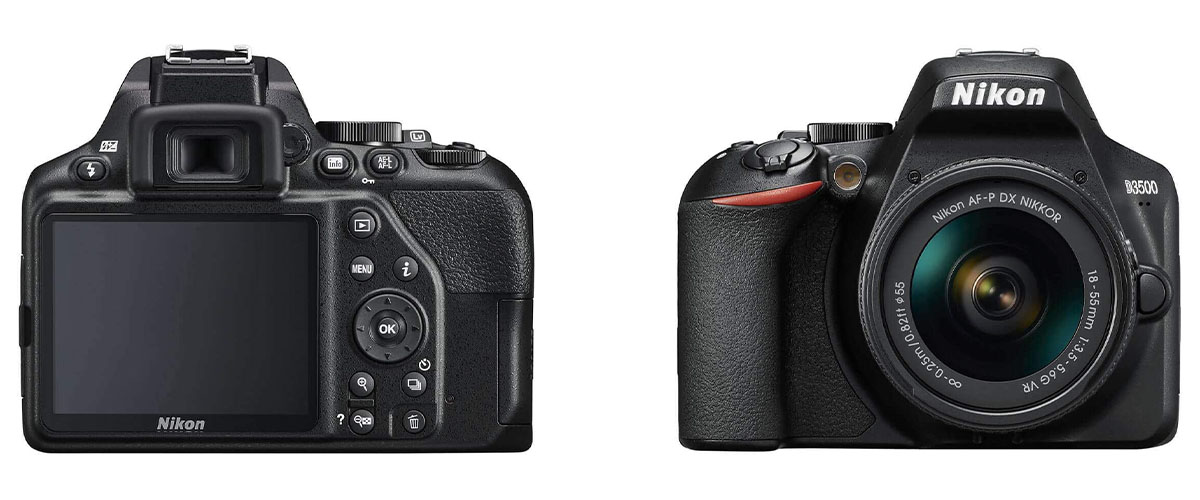
With this Camera, both professionals and amateurs with great imagination and creativity can shoot outstanding images. Its compact and lightweight feature makes it comfortable to shoot images with this Camera. Its fast and responsive feature makes shooting pictures and moving objects easy to capture.
The best part of this Camera is how it captures and interprets colors; every color pops, leading to a full set of rich imaging.
| Pros | Cons |
| Focuses fast on moving subjects to capture blurry free images. | You might experience difficulty trying to control exposure, shutter speed, etc. |
| Lightweight and compact to enjoy the entire shooting experience. | |
| Captures colors in a way that makes them pop in images. |
Mirrorless or DSLR – Which Camera Best for Product Photography
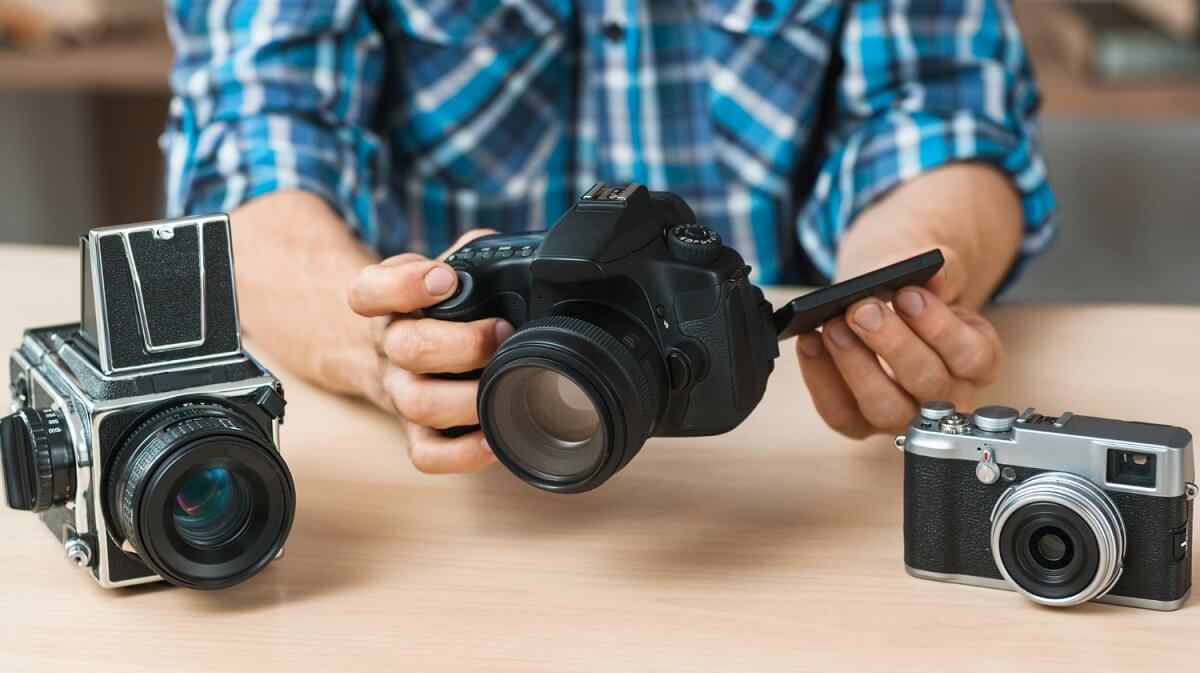
For starters, just as there are high-end DSLR and Mirrorless cameras for product photography, there are also entry-level DSLR and Mirrorless photography. You should also know that regardless of which grade of DSLR or Mirrorless cameras you’re trying to compare, the real question here shouldn’t be “which camera is best for photography” because they are both great for product photography. Instead, the better question to ask is; which Camera is good for you.
In essence, deciding between Mirrorless and DSLR, especially as a beginner photographer, should be more of a preference. That is, which one do you feel comfortable shooting with? The truth is, both cameras are great for photography. It just depends on who’s taking the pictures.
Both cameras are versatile, but they both have areas of strength and weaknesses. However, mirrorless cameras are usually lighter and less bulky compared to the DSLR cameras that present you with different lens options to choose from.
So, as a beginner shopping for entry-level cameras, you’re better of buying an entry-level DSLR camera or entry-level Mirrorless camera. Suppose you get used to learning and training with a DSLR entry-level camera.
In that case, you’ll most likely prefer a professional DSLR camera and vice versa for mirrorless cameras when you become a professional. Whatever you do, never opt for a Point and Shoot Camera. It does little to nothing when it comes to helping you grow your skill as a photographer, as it doesn’t put you in control of the pictures you take, unlike a mirrorless or DSLR camera.
Things To Consider Before Buying A Good Entry-level Camera
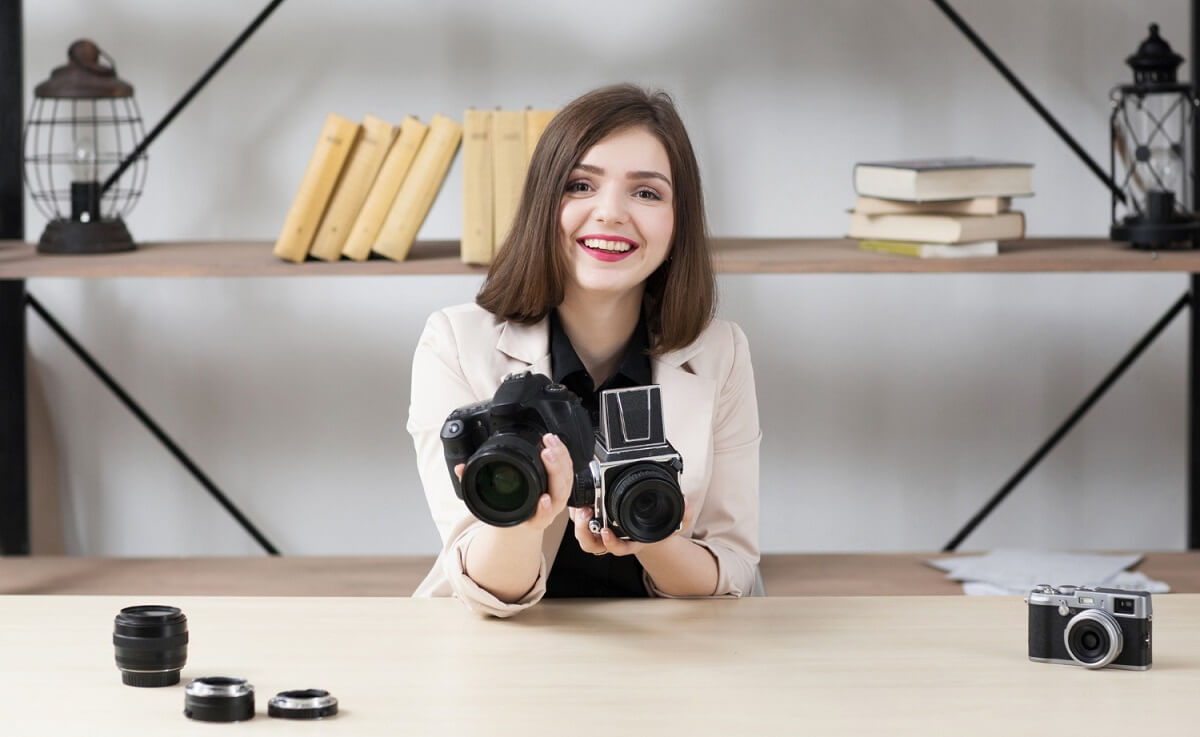
When deciding what to look out for in an entry-level camera, we love that as soon as you buy it, you can start to use it right out of the box without needing to adjust or tweak the settings too much.
Nevertheless, while these cameras are ready for use right out of the box, we also ensured that they allow you to adjust the settings to your taste as you gradually morph from a beginner into a photographer with intermediate skills.
Below, you’ll find some of the features you should look out for when shopping for the best entry-level Camera for your product photography.
Camera Type: The first thing you consider about entry-level cameras before investing in them is the type you want to opt for. There are quite a few entry-level camera types to choose from. There’s the point-and-shoot camera, also referred to as a compact camera. Their lenses are fixed, and you have less control over these camera types.
The DSLR camera is an acronym for the “Digital Single Lens Reflex” camera. In essence, this camera type deploys a single lens to frame, focus, and shoot your picture. Entry-level DSLR cameras are a fantastic choice as they offer great ergonomics and are versatile. Another camera type is the Mirrorless camera. It’s called a mirrorless camera because it lacks a mirror, usually in a DSLR camera.
Nevertheless, this camera type can either come with fixed or interchangeable lenses. They are also impressively lightweight but very resourceful. Other camera types are the bridge, micro-four third, and action cameras.
Interchangeable lenses: Another innovative feature to look out for in an entry-level camera is whether or not it comes with interchangeable lenses. The reason is, your kit lens can’t do a lot of wonders as you’d love to.
However, if the Camera grants you the liberty to change lenses, don’t hesitate to buy or borrow a camera lens from a friend to save cost. If you get a Canon or Nikon entry-level camera, the chances are that it would support changing lenses. If it does, you can shop from the wide array of DSLR lenses from those two brands.
Controls: Entry-level cameras are mostly used by beginners, regardless of what type of Camera it is. As a result, most top entry-level cameras come with simple controls. That is, you’ll easily locate the controls and tell which button does what task. Beginners shouldn’t have to deal with too many complex control buttons on a camera.
Megapixels: The megapixels on an entry-level camera is important as it gives an idea of the Camera’s resolution. If you opt for a camera, opt for one with 16-24 mp.
Manual Modes: While beginners might want to take pictures on automatic modes, try not to get too used to it as it slows down your progress as a photographer. Hence, it’s best to look out for entry-level cameras with manual modes that allow you to adjust the Camera setting yourself so you can take great images. These manual modes include manual focus and exposure
Video: Aside from still image content, videos have become more important in today’s social media world. So, you want to pay attention to the video quality of your Camera. Opt for entry-level cameras with at least full HD 1080p or 4K resolution video at most
FAQS about Best Entry-Level Cameras for Product Photography
What equipment do I need for product photography?
If you plan to DIY your product shoot, consider turning your home into a studio. To achieve that, you’ll need a lot of equipment. They include; a camera, tripod, white bounce cards carved from foam boards, a room with enough natural light, a table, white background, and a tape.
Which Camera brand is great for product photography?
As a beginner shopping for an entry-level camera, you should try quite a few brands. With these brands, you’re guaranteed quality pictures, great features for an entry-level camera, durability, and affordability. These brands are Canon, Nikon, Panasonic, and Sony. You can also try some Fujifilm and Olympus cameras.
Do more megapixels mean better photo quality?
More megapixels translate into higher resolution. In turn, that means that with higher resolution, you’ll get higher quality images that are crisp and are devoid of blur (especially when you zoom into the picture)
Is 24 megapixels camera good?
Yes, it is good, especially for hobbyists and enthusiasts. It gets better if you’re shooting with a fantastic camera lens.
How long does a product photoshoot take?
The time range for a product photoshoot varies. For a standard photoshoot, you’ll need to schedule at least 60 minutes. You might spend up to 1.5 hours to 3 hours if you’re doing a fashion product shoot. It all depends on the space you’re shooting in and other factors.
How can I make my photos look professional?
An easy way to make your product photos look professional is to deploy proper depth of field.
Final Verdict
As a beginner, you shouldn’t worry too much about the types of entry-level cameras that exist. If you’re serious about learning photography yourself for the sake of selling your products, opt for a DSLR or Mirrorless entry-level camera. Trust me; we reviewed more than enough options for you to choose from. As you learn to control these cameras, they’ll make you into a professional faster than you can imagine.
Since you’re a beginner, you might not need to worry about the other gadget parts as you’re towing the DIY photography route. Search for a great product photography concept and get inspired to create yours. With any of the best entry-level cameras for product photography that we reviewed, you can work wonders with the kind of picture your shoot, even as a beginner.
